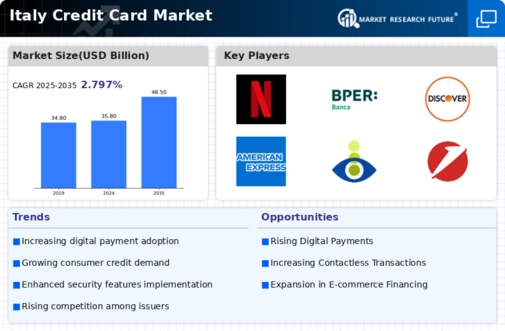Consumer Behavior Shifts
The credit card market in Italy is significantly influenced by evolving consumer behavior. Recent surveys indicate that a growing number of consumers are prioritizing rewards and cashback programs when selecting credit cards. Approximately 60% of new credit card applications in 2025 are driven by the desire for rewards, suggesting a shift in consumer priorities. Additionally, younger demographics are increasingly inclined to utilize credit cards for everyday purchases, further driving market growth. This shift in consumer preferences may compel issuers to innovate their product offerings, focusing on features that align with the desires of a more reward-oriented customer base. As such, understanding these behavioral trends is essential for stakeholders in the credit card market.
Regulatory Changes and Compliance
Regulatory frameworks play a pivotal role in shaping the credit card market in Italy. Recent legislative changes aimed at enhancing consumer protection and promoting transparency are influencing market dynamics. For instance, the introduction of stricter guidelines on interest rates and fees has compelled credit card issuers to reassess their pricing strategies. As of November 2025, compliance with these regulations is expected to impact approximately 30% of credit card products available in the market. This regulatory environment may lead to a more competitive landscape, as issuers strive to offer attractive terms while adhering to compliance requirements. Consequently, the credit card market is likely to witness a shift towards more consumer-friendly offerings, which could enhance overall market growth.
Competitive Landscape and Market Entry
The competitive landscape of the credit card market in Italy is evolving, with new entrants challenging established players. Fintech companies are increasingly offering innovative credit solutions, often with lower fees and more flexible terms. As of 2025, the market share of fintech firms in the credit card sector is estimated to be around 15%, indicating a growing trend towards alternative credit options. This influx of competition may compel traditional banks to enhance their offerings, potentially leading to better terms for consumers. The dynamic nature of the competitive environment suggests that the credit card market will continue to adapt, fostering innovation and potentially benefiting consumers through improved services and pricing.
Economic Factors and Consumer Spending
Economic conditions significantly impact the credit card market in Italy. As of November 2025, the Italian economy is showing signs of recovery, with consumer spending projected to increase by 4% over the next year. This uptick in spending is likely to drive higher credit card usage, as consumers are more willing to finance purchases through credit. Additionally, low-interest rates are encouraging borrowing, which may further stimulate demand for credit cards. The interplay between economic growth and consumer confidence appears to be a crucial driver for the credit card market, as increased spending power could lead to higher transaction volumes and greater market penetration.
Technological Advancements in Payment Systems
The credit card market in Italy is experiencing a notable transformation due to rapid technological advancements. Innovations such as contactless payments and mobile wallet integration are becoming increasingly prevalent. As of 2025, approximately 45% of all credit card transactions in Italy are conducted via contactless methods, reflecting a shift in consumer preferences towards convenience and speed. This trend is likely to continue, as consumers increasingly favor seamless payment experiences. Furthermore, the integration of artificial intelligence in fraud detection systems enhances security, thereby fostering consumer trust in the credit card market. The ongoing evolution of payment technologies appears to be a critical driver, potentially leading to increased adoption rates and higher transaction volumes in the coming years.


















Leave a Comment